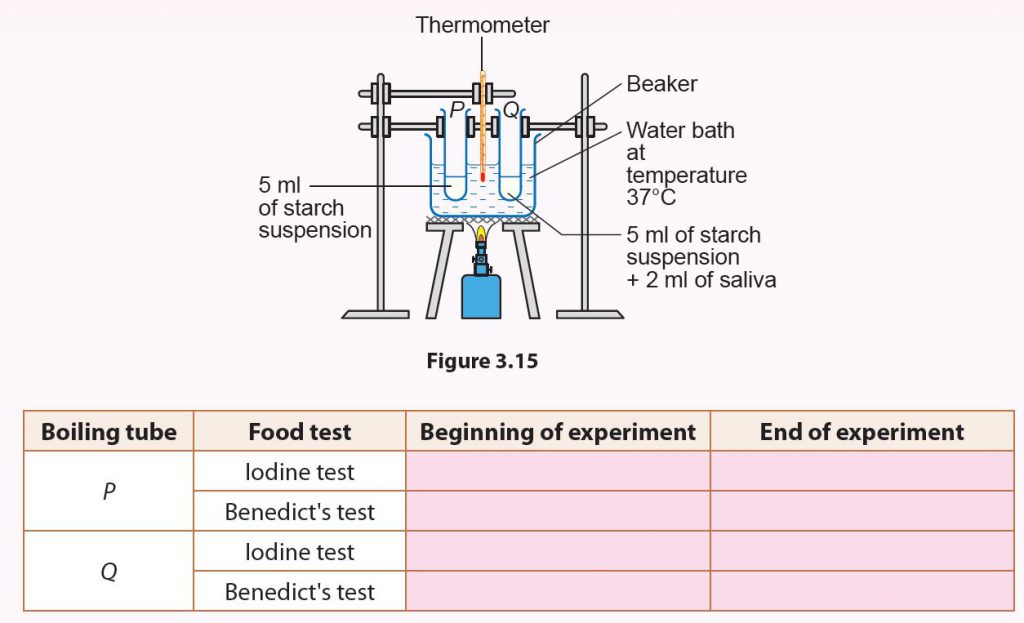Activity 3.7:
Aim: To study the action of enzyme in saliva on starch.
Materials: 1% starch suspension, iodine solution, Benedict’s solution and distilled water
Apparatus: Boiling tube, Bunsen burner, glass rod, wire gauze, 250 ml beaker, test tube, test tube holder, stopwatch, dropper, tripod stand, retort stand with clamp
Instruction
1. Rinse your mouth with distilled water and collect saliva in a small beaker. Use this in step 3.
2. Pour 10 ml of starch suspension into two boiling tubes, P and Q.
3. Add 4 ml of the saliva into boiling tube Q. Stir the mixture with a clean glass rod.
4. Take out 2 ml from each of the boiling tubes and carry out iodine test and Benedict’s test.
5. Place boiling tubes P and Q in a water bath at 37ºC and start the stopwatch (Figure 3.15).
6. After 30 minutes, take out 2 ml from each of the boiling tubes and carry out iodine test and Benedict’s test.
7. Record your observations in a table.

Questions
1. Why does the temperature of the water bath need to be maintained at 37°C?
2. What happens to the starch in boiling tube Q at the end of the experiment?
3. What enzyme is found in our saliva?
Answer:
1. 37ºC is the optimum for action of enzymes/ human body temperature
2. Digested into maltose
3. Amylase
Aim: To study the action of enzyme in saliva on starch.
Materials: 1% starch suspension, iodine solution, Benedict’s solution and distilled water
Apparatus: Boiling tube, Bunsen burner, glass rod, wire gauze, 250 ml beaker, test tube, test tube holder, stopwatch, dropper, tripod stand, retort stand with clamp
Instruction
1. Rinse your mouth with distilled water and collect saliva in a small beaker. Use this in step 3.
2. Pour 10 ml of starch suspension into two boiling tubes, P and Q.
3. Add 4 ml of the saliva into boiling tube Q. Stir the mixture with a clean glass rod.
4. Take out 2 ml from each of the boiling tubes and carry out iodine test and Benedict’s test.
5. Place boiling tubes P and Q in a water bath at 37ºC and start the stopwatch (Figure 3.15).
6. After 30 minutes, take out 2 ml from each of the boiling tubes and carry out iodine test and Benedict’s test.
7. Record your observations in a table.

Questions
1. Why does the temperature of the water bath need to be maintained at 37°C?
2. What happens to the starch in boiling tube Q at the end of the experiment?
3. What enzyme is found in our saliva?
Answer:
1. 37ºC is the optimum for action of enzymes/ human body temperature
2. Digested into maltose
3. Amylase